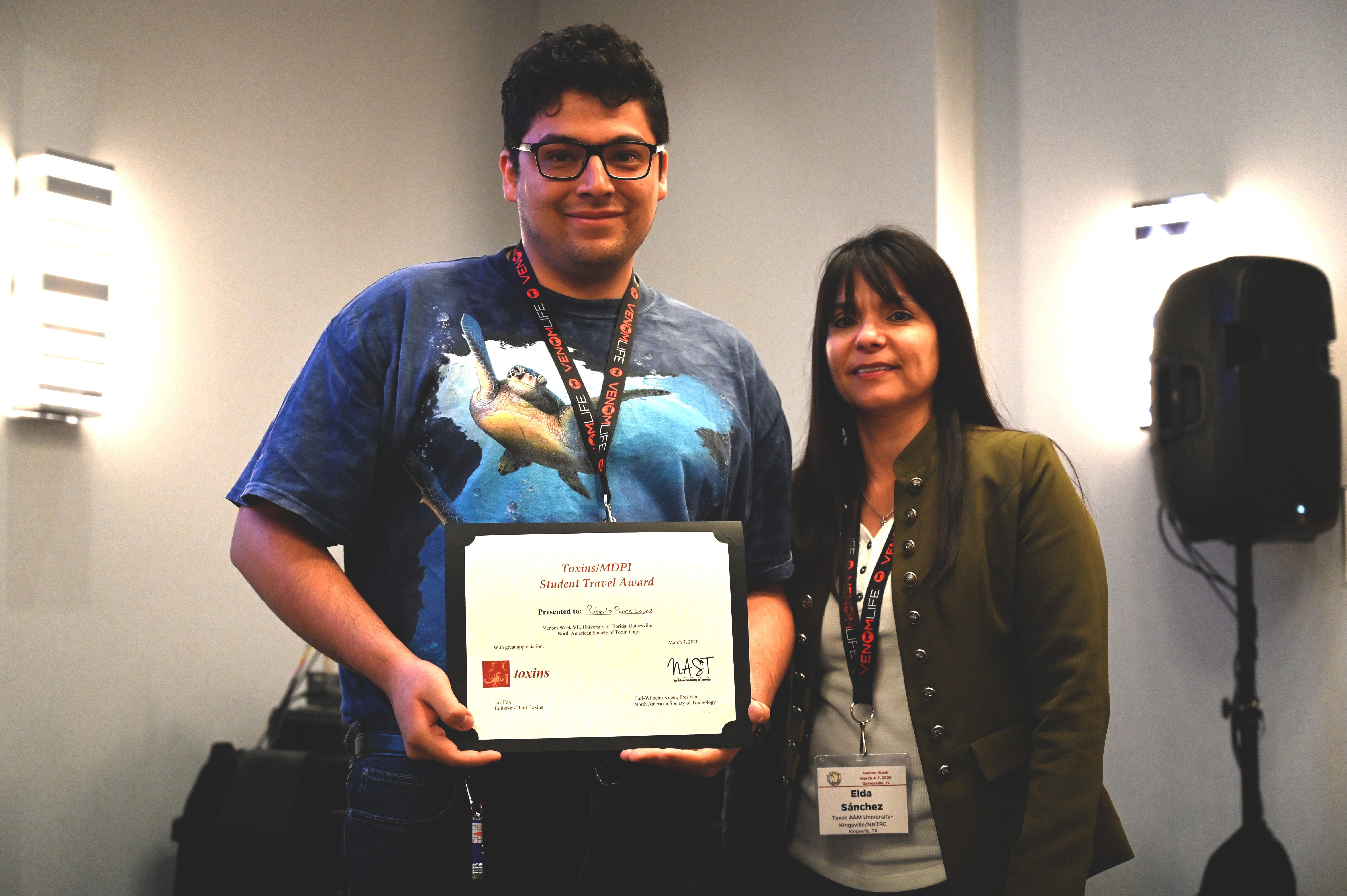
Journal Menu
► ▼ Journal Menu-
- Toxins Home
- Aims & Scope
- Editorial Board
- Reviewer Board
- Topical Advisory Panel
- Instructions for Authors
- Special Issues
- Topics
- Sections & Collections
- Article Processing Charge
- Indexing & Archiving
- Editor’s Choice Articles
- Most Cited & Viewed
- Journal Statistics
- Journal History
- Journal Awards
- Society Collaborations
- Conferences
- Editorial Office
Journal Browser
► ▼ Journal BrowserNeed Help?
Announcements
4 April 2020
Congratulations to the Winner of the Toxins Travel Student Award at Venom Week VII, Gainesville, Florid, USA, 2020 (Sponsored by Toxins)
The editorial team of Toxins would like to congratulate the winner of the Toxins Travel Student Award, Roberto Ponce Lopez, at Venom Week VII.

Here are the title and abstract of his work:
Sphingomylinase D-Crotamine Recombinant Fusion Protein as Immunogen for the Production of Antibodies Against Crotamine
Ponce-López, R.1,*, Olvera-Rodríguez, A.1, Borja-Jiménez, M.2, Neri-Castro, E.1, Olvera-Rodríguez, L.1, Alagón, A.1
1 Instituto de Biotecnología, Universidad Nacional Autónoma de México, Cuernavaca, Morelos, México; rockbert@ibt.unam.mx (P.-L.R.)
2 Facultad de Ciencias Biológicas, Universidad Juárez del Estado de Durango, Gómez Palacio, Durango, México
Background: Crotoxin (molecular weight (MW): ~24 kDa) and crotamine (MW: ~5 kDa) are two of the most studied neurotoxic components found in several rattlesnake venoms (Crotalus spp.). The former compound is well neutralized by antivenoms, whereas the latter is well known for its spastic paralysis symptom provoked in mice with no evidence of neutralization. Recently, it was reported that crotamine is the major toxin found in some neonate and juvenile Mexican rattlesnake venoms such as Crotalus molossus nigrescens (~50%). Currently, the available Mexican pit viper antivenoms neither recognize nor neutralize crotamine from C. m. nigrescens, possibly explained by its low immunogenicity due to its low molecular weight. Sphingomyelinase D (SMD) is a highly immunogenic enzyme (MW: ~30 kDa) found in Loxosceles spp. spider venom. To increase immunogenicity of a low molecular weight toxin, we hypothesized that our novel recombinant fusion protein, composed of crotamine from C. m. nigrescens and sphingomyelinase D from L. reclusa used as carrier, will contribute significantly to the generation of neutralizing antibodies against crotamine, preventing its spastic paralysis and lethality.
Methods: Crotamine cDNA was synthetized from the venom gland mRNA of a C. m. nigrescens individual from Mexico, and one plasmid containing L. reclusa SMD was available in the laboratory. By standard genetic engineering procedures, we cloned in tandem sphingomyelinase D and one crotamine isoform into the expression vector pQE30. This fusion protein was expressed in Origami Escherichia coli. Using the recombinant protein, we performed immunization protocols in rabbits and, during the scheme, we measured ELISA antibody titers to purified crotamine from C. m. nigrescens venom.
Results: The fusion protein was obtained at 3 mg/L of bacterial culture with the expected 37.5 kDa molecular mass as analyzed by SDS-PAGE and Western blot analysis. The fusion protein was lethal in mice (LD50 = 2.8 μg/g weight of mice) showing no effects of spastic paralysis. Based on ELISA and Western blot, serum samples of immunized rabbits reacted to crotamine.
Discussion/Conclusion: The SMD–crotamine fusion protein used as immunogen generates antibodies that recognize crotamine. We are using pre-incubation experiments to analyze the neutralization ability of antibodies to prevent spastic paralysis and lethality from crotamine in mice.
Keywords: crotamine; sphingomyelinase-d; molecular-carrier; recombinant-protein
Acknowledgment: Fordecyt 303045.




